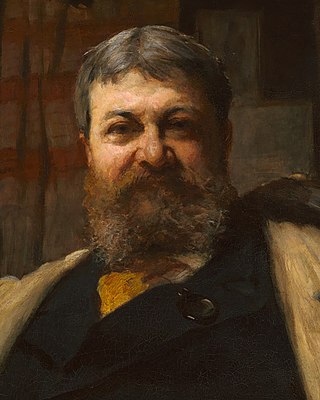
Henry Hobson Richardson, FAIA was an American architect, best known for his work in a style that became known as Richardsonian Romanesque. Along with Louis Sullivan and Frank Lloyd Wright, Richardson is one of "the recognized trinity of American architecture".

The Back Bay Fens, often called The Fens, is a parkland and urban wild in Boston, Massachusetts, in the United States. It was established in 1879. Designed by Frederick Law Olmsted to serve as a link in the Emerald Necklace park system, the Fens gives its name to the Fenway-Kenmore neighborhood.

Longy School of Music of Bard College is a private music school in Cambridge, Massachusetts associated with Bard College. Founded in 1915 as the Longy School of Music, it was one of the four independent degree-granting music schools in the Boston region along with the New England Conservatory, Berklee College of Music, and Boston Conservatory. In 2012, the institution merged with Bard College to become Longy School of Music of Bard College. As of the 2018–19 academic year, the conservatory has 300 students in its degree programs from 35 states and 23 countries.

Horticultural Hall, at the corner of Huntington Avenue and Massachusetts Avenue in Boston, was built in 1901. It sits across the street from Symphony Hall. Since 2020, it has been owned by Northeastern University. It is the current home to The William Morris Hunt Memorial Library of the Museum of Fine Arts as well as to offices of Boston magazine, 829 Studios, and Small Army, in addition to a performance space of the New England Conservatory of Music.
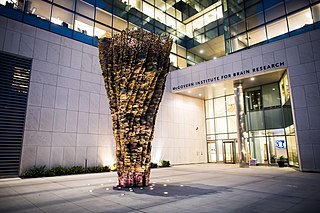
The McGovern Institute for Brain Research is a research institute within MIT. Its mission is to understand how the brain works and to discover new ways to prevent or treat brain disorders. The institute was founded in 2000 by Patrick McGovern and Lore Harp McGovern with a gift to MIT that is expected to total $350M over 20 years.
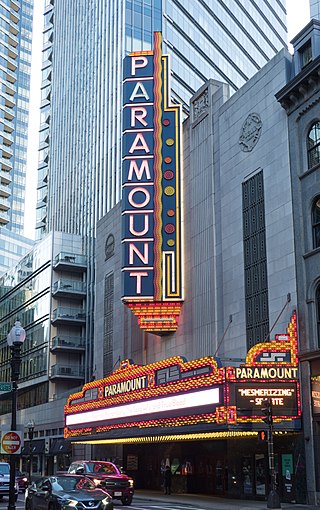
Paramount Theatre is a theatre in Boston on Washington Street, between Avery and West Streets.

The Allegheny County Courthouse in downtown Pittsburgh, Pennsylvania, is part of a complex designed by H. H. Richardson. The buildings are considered among the finest examples of the Romanesque Revival style for which Richardson is well known.
Norcross Brothers Contractors and Builders was a nineteenth-century American construction company, especially noted for their work, mostly in stone, for the architectural firms of H.H. Richardson and McKim, Mead & White. The company was founded by James Atkinson and Orlando Whitney, who were contracted for their first project in 1869. In all, the company is credited with completing over 650 building projects.

Arlington High School is a public high school located in Arlington, Massachusetts. As of 2010, the school enrolls approximately 1,300 students annually. The current principal is Matthew Janger. Currently being rebuilt.

The Christian Science Center is a 13.5-acre (5.5 ha) site on the corner of Massachusetts Avenue and Huntington Avenue in the Fenway neighborhood of Boston, Massachusetts. A popular tourist attraction, the center is owned by the Church of Christ, Scientist, which refers to it as Christian Science Plaza. The complex, including most of the landscape was designated as a Boston Landmark by the Boston Landmarks Commission in 2011.

Fenway, commonly referred to as The Fenway, is a mostly one-way, one- to three-lane parkway that runs along the southern and eastern edges of the Back Bay Fens in the Fenway–Kenmore neighborhood of Boston, in the east-central part of the U.S. state of Massachusetts. As part of the Emerald Necklace park system mainly designed by Frederick Law Olmsted in the late 19th century, the Fenway, along with the Back Bay Fens and Park Drive, connects the Commonwealth Avenue Mall to the Riverway. For its entire length, the parkway travels along the Muddy River and is part of the Metropolitan Park System of Greater Boston. Like others in the park system, it is maintained by the Massachusetts Department of Conservation and Recreation.

Fort Point is a neighborhood or district of Boston, Massachusetts, and where a fort stood which guarded the city in colonial times.

The Crowninshield House is a historic house at 164 Marlborough Street in the Back Bay neighborhood of Boston, Massachusetts. Built in 1870, it is the first residential design of the renowned architect Henry Hobson Richardson. It was added to the National Register of Historic Places in 1972.
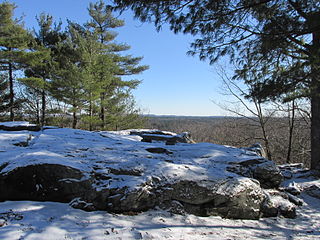
Noon Hill is a 204-acre (83 ha) open space preserve located in Medfield, Massachusetts and centered on 370-foot (110 m) Noon Hill, a prominent summit and scenic vista. It is managed by the land conservation non-profit organization The Trustees of Reservations and offers 4.5 miles (7.2 km) of trails available for hiking, horseback riding, mountain biking, and cross country skiing. Oak-hickory forest, wetlands, vernal pools, steep ravines, boulders, and rocky ledges characterize the preserve. Noon Hill is a link in the 200-mile (320 km) Bay Circuit Trail. Holt Pond, a constructed mill pond, is located on the property.
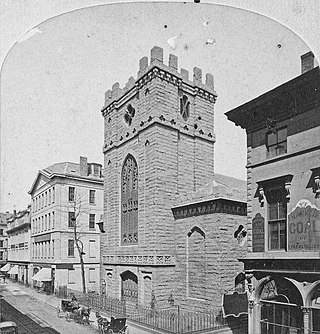
Trinity Church (1735-1872) was an Episcopal church in Boston, Massachusetts, located on Summer Street. It housed Boston's third Anglican congregation. The Great Fire of 1872 destroyed the church building, and by 1877 the congregation moved into a new building in Back Bay.

HLW is a design, architecture and planning firm headquartered in New York City, with offices in Madison, New Jersey; Stamford, Connecticut; Los Angeles, California; London; and Shanghai. HLW is one of the oldest design firms in the United States, tracing its beginnings to 1885.

Park Drive is a mostly one-way, two-lane parkway in the Fenway-Kenmore neighborhood of Boston that runs along the northern and western edges of the Back Bay Fens before ending at Mountfort Street. As part of the Emerald Necklace park system mainly designed by Frederick Law Olmsted in the late 19th century, Park Drive, along with the Back Bay Fens and the Fenway, connects the Commonwealth Avenue Mall and Boylston Street to Beacon Street and the Riverway. For a portion of its length, the parkway runs along the Muddy River and is part of the Metropolitan Park System of Greater Boston's Muddy River Reservation. Like others in the park system, it is maintained by the Massachusetts Department of Conservation and Recreation.
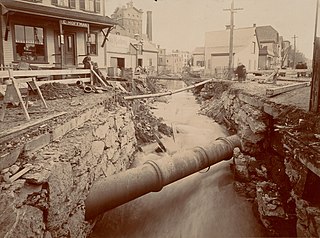
Stony Brook is a 8.5-mile (13.7 km)-long subterranean river in Boston. The largest tributary stream of the lower Charles River, it runs mostly through conduits. Stony Brook originates at Turtle Pond in the Stony Brook Reservation and flows through Hyde Park, Roslindale, Jamaica Plain, and Roxbury. It empties into the Charles River Basin just upstream of the Harvard Bridge. Stony Brook is fed by four tributaries, all of which are partially or entirely in conduits as well.

Stony Brook is a stream largely running through Lincoln and Weston, Massachusetts, then forming the Weston/Waltham boundary, and emptying into the Charles River across from the Waltham/Newton boundary. It has two tributaries, Cherry Brook and Hobbs Brook, and its watershed includes about half of Lincoln and Weston as well as parts of Lexington and Waltham. Since 1887, it has been the water supply for Cambridge, along with the Hobbs Brook Reservoir.
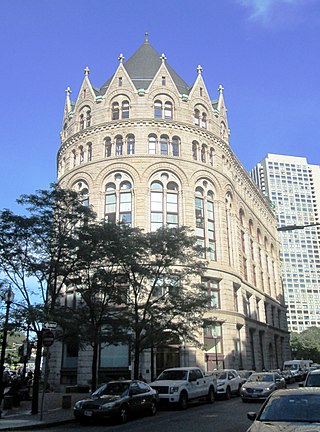
The Flour and Grain Exchange Building is a 19th-century office building in Boston. Located at 177 Milk Street in the Custom House District, at the edge of the Financial District near the waterfront, it is distinguished by the large black slate conical roof at its western end. It is referred to as the Grain Exchange Building and sometimes as the Boston Chamber of Commerce Building.



















